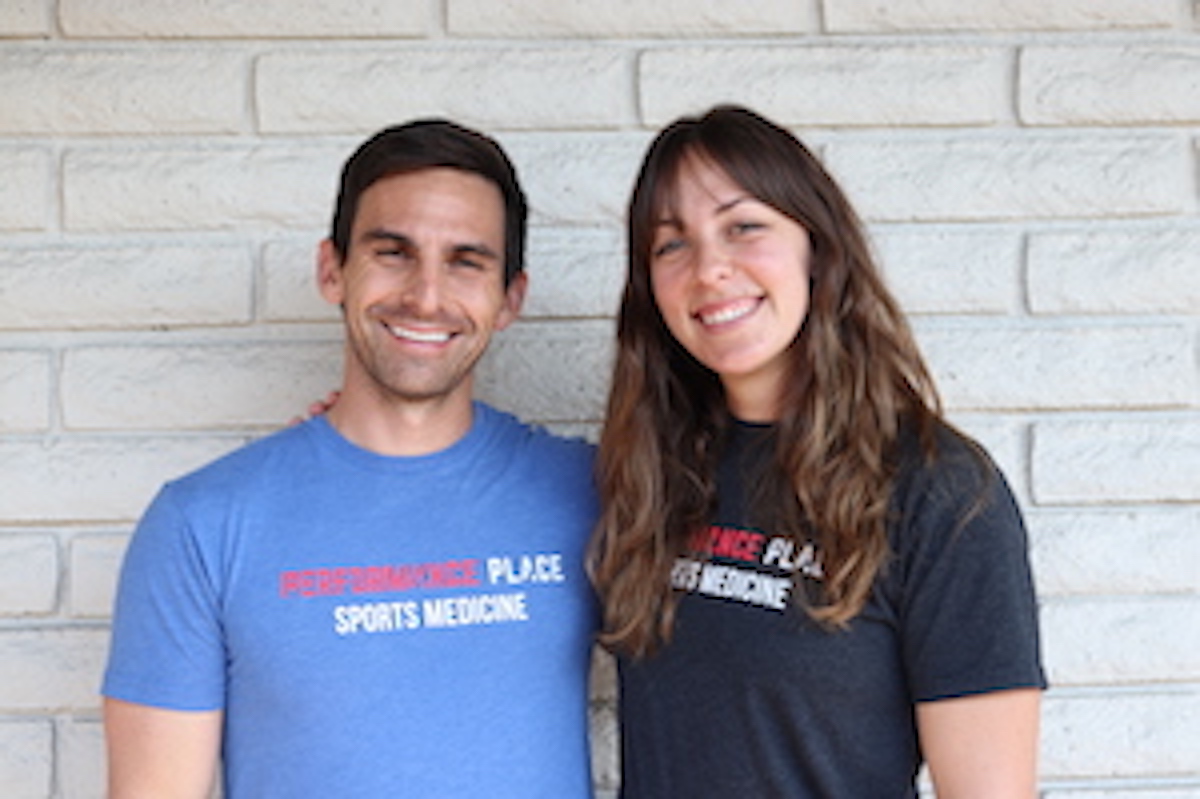7 Best Treatments for Pickleball Elbow – Signs, Symptoms & Causes
Pickleball elbow (tennis elbow & lateral epicondylitis) is the number one cause of outer elbow pain while playing pickleball. Racket sports like pickleball, tennis, racketball tend to carry the risk of outer elbow pain, which can present as an achy, throbbing, or sharp pain in the elbow.
The common myth is that rest and a soft brace are the best ways to fix pickleball elbow. In this article, I’ll present a new way of looking at elbow pain and present effective treatments for pickle elbow so you can get back on the court as soon as possible.
Hi, I’m Sebastian Gonzales with Performance Place Sports Care in Costa Mesa CA. Call us if you want help at 714-502-4243
Navigate this entire article by using the table of contents at the top of your mobile device (or sidebar on PC). We will cover all of the following.
- Signs & Symptoms of Pickleball Elbow
- What Causes Pickleball Elbow?
- Treatment For Pickleball Elbow

Signs & Symptoms of Pickleball Elbow
Symptoms of pickleball elbow include:
Pain or discomfort on the outside of the elbow. Palpation along the elbow will reveal tenderness around the boney outer elbow (below the lateral epicondyle of the arm bone).
Many players note outer elbow pain increases with gripping their fists, shaking hands, opening doors, holding coffee mugs and dinner plates, weightlifting, and even typing. It is common to experience weakness of grip as well.
Elbow pain may increase in pain at night, as many people will wake up as they roll onto their elbow. Yet many report elbow pain while laying on their back or opposite side.
Pickleball elbow will present as elbow pain on one side only. Elbow pain on both sides, in a similar presentation, will likely be due to another cause.
Pain may travel down the outer part of the elbow to the muscles of the forearm. Numbness and tingling of the hand in any fashion indicate there is probably a pinched nerve in the neck or elbow region, as pickleball elbow does not create nerve compression in its pure form. Change of sensation of both hands indicates the nerve compression is in the neck or skull regions.
What Causes Pickleball Elbow?
Pickleball elbow is commonly thought to be from overuse of the muscles of the elbow/ forearm. Overuse of the muscles and tendons of the elbow can occur in 3 situations. Elbow problems tend to not be problems with only the elbow.
Situation 1: A historically normal elbow with an abnormal amount of play. We have all had muscle soreness from doing too much activity too soon. I remember when I played pickleball for the first time for 3 hours straight. I was sore in the knees, lower back, and right elbow. Does this mean there is anything wrong with my body? Not necessarily. It means I did too much too soon. It was a dramatic spike in activity level.
When this situation occurs over and over again, we discuss the concept of “load management” with our clients. Too much load on the elbow, too soon, without a “gradual build-up of playtime,” tends to lead to elbow pain. Give your body time to adapt. Play 1 hour today, 1 hour tomorrow, 1 hour the next day, and so on. Week 2: play an hour and a half daily. Week 3: add another 30 minutes. A simple solution, in this case, is to decrease spikes of activity, especially after times of inactivity (as many people experienced during shelter in place orders).
Situation 2: A previously weak elbow becomes painful with normal playtime. You have been playing for months, being responsible, not overdoing it and out of the blue, your elbow starts to hurt. In this situation, you may have exposed an area of your body that was susceptible to injury with normal playtime (loads). This is the most common type of pickleball elbow and can be resolved with the rehabilitation of the elbow, as well as the whole arm. Building a strong elbow requires the building of the hand, wrist, elbow, shoulder, and neck. The weakest link in the upper limb will begin to hurt the next if you only strengthen the elbow.
Situation 3: You have a normal elbow, normal playtime and you still get elbow pain out of the blue. In this situation, we have considered the rest of the limb. The body works as one unit. You can not hit the ball without using your hand, wrist, elbow, shoulder, core, legs, neck, and so on. You need the rest of your body to assist in the backhand.
About 40% of the pickleball elbow cases we see at Performance Place are due to other areas of the body that are not working well. These trouble areas also do not hurt. Just because a joint does not hurt, does not mean it functions well.
We all know someone with a neck that doesn’t move through a full range of motion, yet their neck does not hurt. In the case of elbow pain, the shoulder is a highly probable non-painful, dysfunctional region. The shoulder is also required to function well if you are to backhand a pickleball.
The shoulder complex (shoulder joint and shoulder blade muscles) is a non-painful, not functioning area in many athletes with inner and outer elbow pain. Research has related shoulder dysfunction to elbow pain in baseball pitchers, golfers, tennis players, and much more.
Many articles you have read may blame poor mechanics during backhand shots for elbow pain. While I don’t disagree, it is not the low-hanging fruit in recovery. While we can always blame the driver for losing a race, we should also consider the car. Maybe the driver (your mechanics) was excellent, but the car (your body) needed a tune-up.
Treatment For Pickleball Elbow
Effective treatment for pickleball elbow is based on the situation you fall into as discussed in the prior section.
1. Rest
Rest tends to work well for players in situation 1, where you have played too much, too soon. Your body is very resilient and can repair on its own most of the time if you give it a chance. 5 days of rest should do the trick. Go watch others play pickleball, work on your footwork or go relax with a cup of coffee with non-picklers.
2. Ice Your Elbow
This works best with chronic cases of situation 1. Icing the elbow is helpful for the reduction of pain, but over the last 10 years, the effectiveness of icing has come under fire. Icing reduces pain and swelling when a player needs to play again in under 24 hours. If you are a recreational player who can afford a few days off, icing may not be the best idea.
New injuries develop inflammation around the elbow tendon. Inflammation is a naturally occurring process. Inflammation can help heal the area. Reducing pain can come in other forms, such as not doing the activities that create pain for a few days. Don’t test the area. Trust in the process and relax.
3. Home therapy exercises “Physical Therapy”
Home therapy exercises for pickleball elbow can be helpful in situations 2 and 3. These are sometimes called “physical therapy,” yet the exercises can be prescribed by chiropractors, acupuncturists, medical doctors, and even medical exercise specialists. In situation 2, the therapy exercises may be more directed at the elbow itself, while in situation 3 we would be trying to strengthen the supporting cast for the elbow (shoulder, wrist, hand, and neck).
Some great starting exercises for situation 2 are: front planks and grip strengthening, such as towel squeezing and rice grabs tend to work nicely.
In situation 3, exercises targeting areas that are NOT the elbow are a good bet. Side planks, low bears, and banded face pushes (for shoulder blade and neck function) are great starting points.
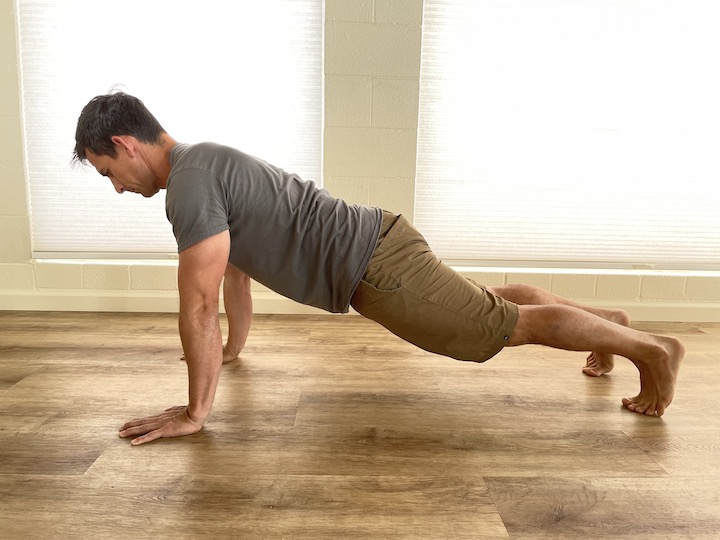
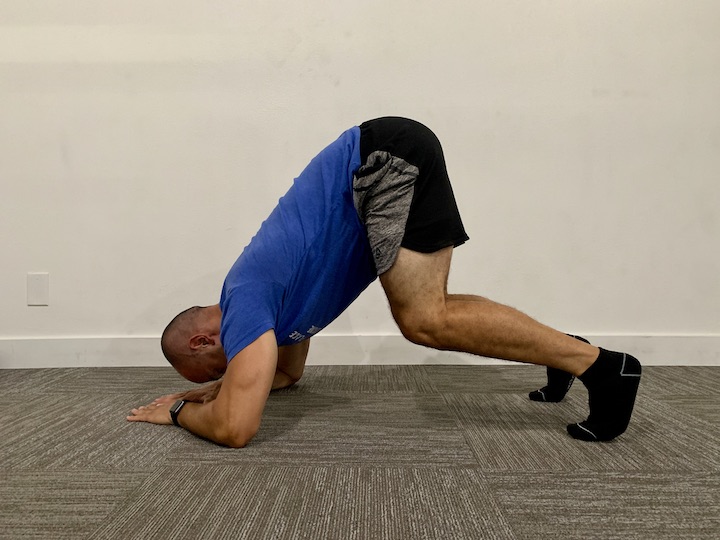
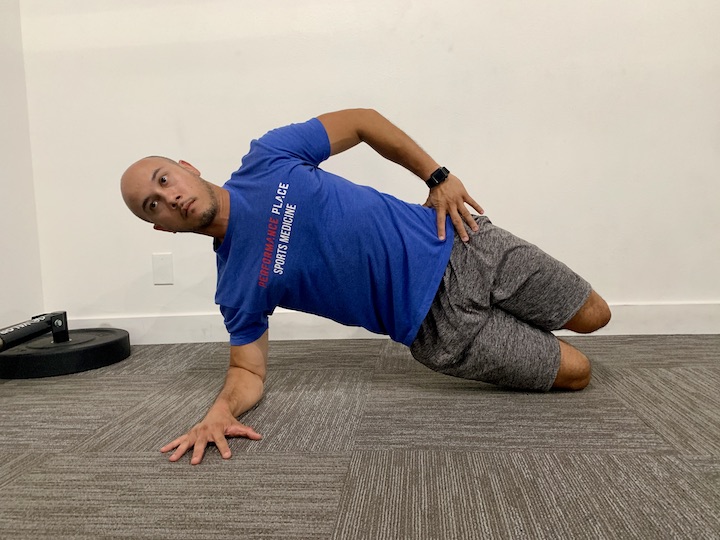
Note: Many of these home therapy exercises work in the right situation but HOW you perform the exercises is more important than you’d think. The magic of a therapy exercise is just doing the exercise. Form, tension, workload, and what you feel working the most are important measurements for a skilled rehab specialist to decide if each therapy exercise is right for you. Regressions and progression are made accordingly. We all hate physical therapy exercises that feel like they don’t do anything and aren’t hard. A skilled coach can help you fine-tune them for your abilities.
4. Stretching
Stretching tends to work well in situations 2 and 3 if you stretch the correct areas. Stretching the elbow itself tends to help reduce pain while stretching joints and muscles areas that may need more flexibility to function well tend to work. I like to target the elbow and finger extensors, mid-back, and shoulder with the static stretches below. Hold each for 20-30 seconds and repeat 5 times, 3 times a day for a week.
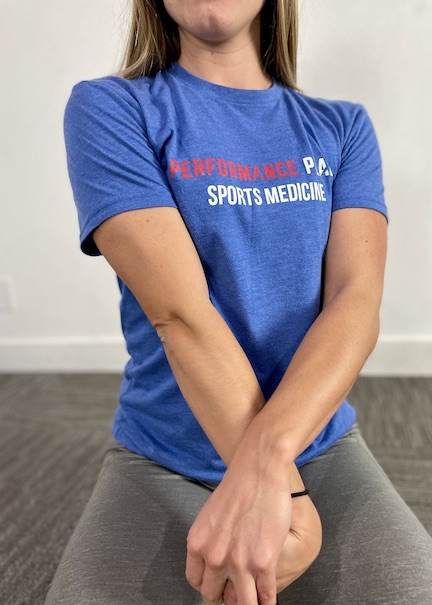
5. Agility and Footwork
In all 3 situations, footwork and using your body to get into the right position to have proper swing mechanics is important. While I won’t go as far to say this is the best way to reduce your elbow pain, it is a great way to prevent it from moving forward.
How can you improve your footwork and agility?
Simple, start moving with intention. Turning up the intensity of play by 25% typically gets people to improve their footwork without over-coaching. Driving fast, most people inherently pay more attention than when crawling through a parking lot while texting. Option 2 is watch Youtube like the rest of us do 🙂 Here is a video that may help you finding drill options.
6. Getting the right racket
In all 3 situations, having the right tools for your trade are important. Having the right racket and grip can make a world of difference in the prevention of pickle elbow.
7. Coaching
In all 3 situations, having an experienced coach is important for safety in recreational pickling as well as sports performance. I can write all day about the various professional sports who find the value of a coach, but we all know deep inside that coaching/ tips are important. If you’re serious about pickling for years to come, make sure you know how to use your body. Just like NASCAR, the driver is just as important as the car. Read the manual. Get a coach. Here is a new Youtube video on backhand form.
If you’re struggling to find an answer for your pickleball elbow, contact us. We have virtual and in-person services where we can help you recover. Yes… you read that correctly. We can help you with pickleball elbow virtually and do not need to place our hands on you to help you feel better. Therapy exercises and stretches can be shown and coached through Zoom. Many times better than any medication or injection you can buy.
Give us a shot. We have all 5-star reviews on Google. Contact us here.
Good luck in your recovery!
Sebastian
